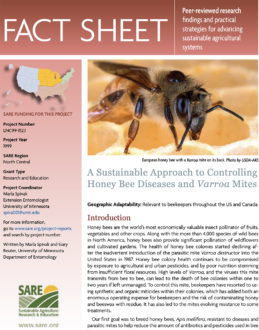Arathi, H.S. and M. Spivak. 2001. Influence of colony genotypic composition on the performance of hygienic behavior in the honey bee (Apis mellifera L). Animal Behavior 62: 57–66.
Gramacho, K.P. and M. Spivak. 2003. Differences in olfactory sensitivity and behavioral responses among honey bees bred for hygienic behavior. Behav. Ecol. Sociobiol. 54: 472–479.
Harbo, J.R. and R.A. Hoopingarner. 1997. Honey bees (Hymenoptera: Apidae) in the United States that express resistance to Varroa jacobsoni (Mesostigmata: Varroidae).Journal of Econ. Entomol. 90: 893–898.
Harbo, J.R. and J.W. Harris. 1999. Selecting honey bees for resistance to Varroa jacobsoni. Apidologie 30: 183–196.
Harbo, J.R. and J.W. Harris. 2005. Suppressed mite reproduction explained by the behaviour of adult bees. Journal of Apicultural Research 44(1): 21–23.
Ibrahim, A., G.S. Reuter and M. Spivak. 2007. Field trial of honey bee colonies bred for mechanisms of resistance against Varroa destructor. Apidologie 38: 67–76.
Ibrahim, A. and M. Spivak. 2006. The relationship between hygienic behavior and suppression of mite reproduction as honey bee mechanisms of resistance to Varroa destructor. Apidologie 37: 31–40.
Lapidge, K., B. Oldroyd and M. Spivak. 2002. Seven suggestive quantitative trait loci influence hygienic behavior of honey bees. Naturwissenschaften 89: 565–568.
Masterman, R., R. Ross, K. Mesce and M. Spivak. 2001. Olfactory and behavioral response thresholds to odors of diseased brood differ between hygienic and non-hygienic honey bees (Apis mellifera L.). J. Comp Physiol. A 187: 441–452.
Spivak, M. 1996. Honey bee hygienic behavior and defense against Varroa jacobsoni. Apidologie 27: 245–260.
Spivak, M. and D. Downey. 1998. Field assays for hygienic behavior in honey bees (Apidae: Hymenoptera). J. Econ. Entomol. 91: 64–70.
Spivak, M. and M. Gilliam. 1993. Facultative expression of hygienic behaviour of honey bees in relation to disease resistance. J. Apicul. Res. 32(3/4): 147–157.
Spivak, M. and M. Gilliam. 1998. Hygienic behaviour of honey bees and its application for control of brood diseases and varroa mites. Parts I and II: Hygienic behaviour and resistance to American foulbrood. Bee World 79: 124-134; 165–182.
Spivak, M., R. Masterman, R. Ross and K.A. Mesce. 2003. Hygienic behavior in the honey bee (Apis mellifera L.) and the modulatory role of octopamine. J. Neurobiol. 55: 341–354.
Spivak, M. and G.S. Reuter. 1998a. Performance of hygienic honey bee colonies in a commercial apiary. Apidologie 29: 285–296.
Spivak, M. and G.S. Reuter. 1998b. Honey bee hygienic behavior. Amer. Bee J. 138: 283–286.
Spivak, M. and G.S. Reuter. 2001a. Resistance to American foulbrood disease by honey bee colonies, Apis mellifera, bred for hygienic behavior. Apidologie 32: 555–565.
Spivak, M. and G.S. Reuter. 2001b. Varroa jacobsoni infestation in untreated honey bee (Hymenoptera: Apidae) colonies selected for hygienic behavior. J. Econ. Entomol 94: 326–331.
Swanson, J., B. Torto, S. Kells, K. Mesce, J. Tumlinson and M. Spivak. 2009. Volatile compounds from chalkbrood Ascosphaera apis infected larvae elicit honey bee (Apis mellifera) hygienic behavior. J. Chem. Ecol. 35: 11088–1116.
About the Authors
Marla Spivak and Gary Reuter
Department of Entomology, University of Minnesota
